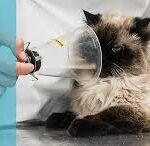Introduction
Meowing cats are a common sight in households around the world. Whether they’re seeking attention, expressing hunger, or simply communicating with their owners, understanding why meow is essential for any cat parent. In this comprehensive guide, we’ll delve into the intricacies of meowing cats and provide practical tips on how to address their needs.
Table of Contents
Why Do Meowing Cat?
Meowing Cats are known for their diverse vocalizations, but meowing is one of the most common sounds they make. Contrary to popular belief, cats don’t just meow to communicate with humans; they also use it as a form of communication with other cats. Understanding the reasons behind meowing can help decipher what your feline friend is trying to convey.
Attention Seeking
One of the primary reasons of cat meowing is to seek attention. Whether they’re craving affection, playtime, or simply want to be near their owners, meowing is their way of saying, “Pay attention to me!” If your cat is meowing persistently, it may be because they want some quality time with you.
Hunger

Another common reason for cat meowing is hunger. Just like humans, cats have specific mealtimes, and if their bowl is empty or they’re feeling peckish between meals, they’ll let you know with a meow. Ensuring your cat has access to fresh food and water can help alleviate their hunger and reduce excessive meowing.
Stress or Anxiety
Stress or anxiety can also manifest in cat meowing. Changes in their environment, such as moving to a new home or introducing a new pet, can trigger stress in cats, leading to increased vocalization. Providing a safe and comfortable space for your cat and gradually introducing changes can help reduce their meowing due to stress.
Medical Issues of Meowing Cat
In some cases, excessive cat meowing could be a sign of underlying medical issues. Conditions such as hyperthyroidism, dental problems, or cognitive dysfunction can cause discomfort or pain, leading to increased vocalization. If your cat‘s meowing seems out of the ordinary or accompanied by other symptoms, it’s essential to consult with a veterinarian for a thorough examination.
How to Respond to Your Meowing Cat
Meowing Cat that we understand the reasons behind cat meowing, let’s explore how to respond effectively to your feline friend‘s vocalizations.
Provide Attention and Affection

If your cat is meowing for attention, it’s essential to acknowledge their needs. Spend quality time with them, engage in interactive play sessions, or simply offer some gentle petting to reassure them. By meeting their need for attention, you can help reduce excessive meowing.
Maintain a Consistent Feeding Schedule
To address meowing due to hunger, establish a consistent feeding schedule for your cat. Divide their daily food intake into several small meals throughout the day and stick to the same feeding times. This routine can help regulate their hunger and reduce meowing associated with food cravings.
Create a Calm Environment for Meowing Cat
To alleviate stress-related Meowing Cat, create a calm and soothing environment for your cat. Provide hiding spots, vertical spaces, and comfortable bedding where they can retreat and feel safe. Additionally, consider using pheromone diffusers or calming supplements to promote relaxation and reduce anxiety-induced meowing.
Schedule Regular Veterinary Check-Ups
Regular veterinary check-ups are essential for maintaining your Meowing Cat’s overall health and addressing any medical issues promptly. Schedule annual wellness exams and seek immediate veterinary attention if you notice any changes in your cat‘s meowing patterns or behavior. Early detection and treatment can prevent medical-related meowing and ensure your cat stays healthy and happy.
The Psychological Aspects of Cat Meowing
Understanding cat meowing goes beyond recognizing the immediate needs of our feline friends; it involves delving into the psychological aspects of their vocalizations. Research suggests that cats use meowing not only as a means of communication but also as a way to express their emotions and establish social bonds.
Emotional Expression of Meowing Cat
Just like humans, cats experience a range of emotions, and Meowing Cat serves as a vocal outlet for expressing these feelings. Studies have shown that the pitch, duration, and intensity of cat meowing can vary depending on their emotional state. For example, a cat may emit short, high-pitched meows when excited or playful, while prolonged, low-pitched meows may indicate distress or discomfort.
Social Bonding for Meowing Cat
In addition to conveying emotions, cat meowing plays a crucial role in social bonding between cats and their human companions. Research has found that cats modify their meowing behavior based on their interactions with humans, often using different vocalizations to solicit attention, food, or affection. This adaptive communication style strengthens the bond between cats and their owners, fostering a sense of trust and companionship.
Cognitive Development
The ability to understand and respond to cat meowing can also have a significant impact on the cognitive development of both cats and humans. Studies suggest that engaging in vocal interactions with cats stimulates their cognitive functions, including memory, problem-solving, and social cognition. Likewise, interpreting and responding to cat meowing enhances human empathy and communication skills, leading to a deeper understanding of our feline companions.
Environmental Influences
Environmental factors can also influence cat meowing behavior, highlighting the importance of providing a stimulating and enriching environment for our feline friends. Research has shown that cats living in enriched environments with opportunities for play, exploration, and social interaction exhibit fewer instances of excessive meowing compared to those in barren or stressful environments. By enriching their surroundings with toys, scratching posts, and interactive play sessions, we can help reduce cat meowing and promote overall well-being.
Practical Strategies for Managing Cat Meowing
Armed with a deeper understanding of the psychological aspects of cat meowing, let’s explore practical strategies for managing and addressing feline vocalizations effectively.
Positive Reinforcement
Positive reinforcement techniques can be highly effective in modifying cat meowing behavior. When your cat exhibits desired behavior, such as quiet meowing or appropriate vocalizations, be sure to praise and reward them with treats, toys, or affection. This encourages the repetition of desirable behaviors while discouraging excessive meowing.

Environmental Enrichment
As mentioned earlier, providing an enriched environment is essential for reducing cat meowing and promoting mental and physical stimulation. Invest in cat-friendly furniture, such as climbing trees and hiding spots, and rotate toys regularly to prevent boredom. Interactive puzzle feeders and treat-dispensing toys can also engage your cat‘s natural hunting instincts and provide mental stimulation, reducing the need for excessive meowing.
Consistency and Patience of Meowing Cat
Consistency is key when addressing cat meowing behavior. Establishing and maintaining a routine for feeding, playtime, and social interaction can help regulate your cat‘s vocalizations and reduce uncertainty or anxiety. Be patient and understanding with your cat, especially if they’re adjusting to changes in their environment or experiencing stress-related meowing. With time and patience, you can help your feline friend feel more secure and confident, leading to a decrease in meowing.
Meowing Cat
cat meowing is a complex form of communication that encompasses emotional expression, social bonding, and cognitive development. By understanding the psychological aspects of cat meowing and implementing practical strategies for management, we can strengthen our bond with our feline companions and ensure their overall well-being. Remember to provide a stimulating environment, use positive reinforcement techniques, and maintain patience and consistency in your interactions with your cat. With dedication and empathy, you can navigate cat meowing with confidence and foster a harmonious relationship with your feline friend.
Conclusion
In conclusion, meowing cats communicate a variety of needs and emotions through their vocalizations. By understanding the reasons behind cat meowing and responding appropriately, you can strengthen the bond with your feline companion and ensure their well-being. Remember to provide attention, maintain a consistent feeding schedule, create a calm environment, and prioritize regular veterinary care to address meowing effectively. With patience and understanding, you can navigate cat vocalizations with confidence and provide the best possible care for your feline friend.





























































